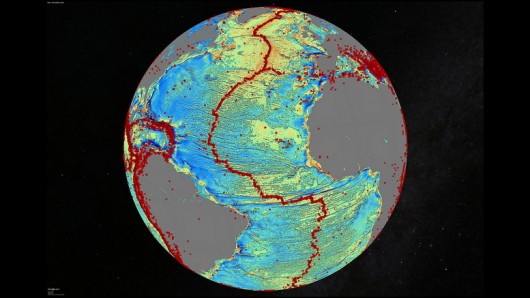New map shows world's seafloor in unprecedented detail
By Darren Quick
October 3, 2014

A new map of the seafloor is twice as accurate as the previous version (Image: David Sandwell, Scripps Institution of Oceanography, UC San Diego)
Given they aren't covered by oceans, it's maybe not so surprising that we know more about the topography of the Moon and Mars than we do about Earth's ocean depths. But researchers have evened the score at least a little with the creation of a new map of the world's seafloor. Twice as accurate as the previous version produced almost 20 years ago, the new map details thousands of previously uncharted mountains and provides new clues on the formation of the continents.
The new map's accuracy is thanks to improved remote sensing instruments and access to two previously untapped streams of satellite data. These come from the ESA's CryoSat-2, which is usually focused on monitoring polar ice volume but also operates continuously over the oceans, and NASA's Jason-1, which was redirected to map Earth's gravity field during the last year of its 12-year mission. Data from these satellites was combined with existing data and used to develop a scientific model that captures gravity measurements on the ocean seafloor.
The end result is a map that has revealed details of thousands of undersea mountains that reach a kilometer (0.6 mi) or more from the ocean floor, providing geophysicists with new tools to analyze ocean spread centers and remote ocean basins, and shedding new light on the tectonics of the deep oceans.
"The kinds of things you can see very clearly now are abyssal hills, which are the most common land form on the planet," said David Sandwell, lead scientist of the study and a geophysics professor in the Cecil H. and Ida M. Green Institute of Geophysics and Planetary Physics (IGPP) at the Scripps Institution of Oceanography.
The map has also revealed for the first time newly exposed continental connections across South America and Africa, and new evidence for seafloor spreading ridges at the Gulf of Mexico that were active 150 million years ago, but are now buried by a layer of sediment 1.6 km (1 mi) thick.
"One of the most important uses of this new marine gravity field will be to improve the estimates of seafloor depth in the 80 percent of the oceans that remains uncharted or is buried beneath thick sediment," the authors say in the report.
The new map will also allow the forthcoming new version of Google's ocean maps to fill large voids between depth profiles provided by shipboard surveys.
The video below details the new map, which can be accessed here.